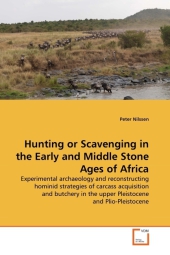 Neuerscheinungen 2011Stand: 2020-01-07 |
Schnellsuche
ISBN/Stichwort/Autor
|
Herderstraße 10
10625 Berlin
Tel.: 030 315 714 16
Fax 030 315 714 14
info@buchspektrum.de |

Peter Nilssen
Hunting or Scavenging in the Early and Middle Stone Ages of Africa
Experimental archaeology and reconstructing hominid strategies of carcass acquisition and butchery in the upper Pleistocene and Plio-Pleistocene
2011. 688 S.
Verlag/Jahr: VDM VERLAG DR. MÜLLER 2011
ISBN: 3-639-37474-6 (3639374746)
Neue ISBN: 978-3-639-37474-2 (9783639374742)
Preis und Lieferzeit: Bitte klicken
Evaluating inferences about hominid meat-eating behaviours is the primary objective of this book. Many scholars consider these behaviours as critical features in human evolution. Most zooarchaeologists agree that butchery marks constitute the most reliable gauge of hominid involvement with animal bones. I focus on cut marks because experiments focused on their placement and frequencies produced by various butchery activities. Many reconstructions of hominid meat-eating behaviours were based on Binford´s observations of the Nunamiut. The primary shortcoming of the latter studies is that cut marks produced by different butchery activities were not separable into categories related to specific butchery activities, because several butchery procedures were performed on the same bones. The present study remedies this situation by separating butchery activities so that cut marks could unambiguously be assigned to specific butchery procedures. A revised inventory of cut marks and their associated behaviours is presented. Evaluating cut marks indicate that Early and Middle Stone Age hominins had different access to animal carcasses.
Peter obtained a PhD from the Univ. of Cape Town in 2000, and was key in initiating the globally renowned archaeological investigation at Pinnacle Point, South Africa. Peter resigned from academia in 2006 and is a consulting archaeologist for Environmental Impact Assessments in South Africa. Peter´s family live on SA´s Cape South Coast.


